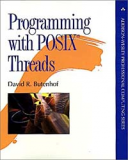Книга: Programming with POSIX® Threads
1.9.1 Architectural overview
1.9.1 Architectural overview
You may remember from Section 1.2 that the three essential aspects of a thread system are execution context, scheduling, and synchronization. When you evaluate any thread system, or compare any two thread systems, start by categorizing the features into capabilities that support execution contexts, scheduling, and synchronization.
With Pthreads, you create an execution context (thread) by calling pthread_ create. Creating a thread also schedules the thread for execution, and it will begin by calling a "thread start function" that you specified. Pthreads allows you to specify scheduling parameters either at the time you create the thread, or later on while the thread is running. A thread normally terminates when it calls pthread_exit, or returns from the thread start function, although we will encounter a few other possibilities later.
The primary Pthreads synchronization model uses mutexes for protection and condition variables for communication. You can also use other synchronization mechanisms such as semaphores, pipes, and message queues. A mutex allows one thread to lock shared data while using it so that other threads cannot accidentally interfere. A condition variable allows a thread to wait for shared data to reach some desired state (such as "queue not empty" or "resource available").
- System Application Overview
- Overview of Fedora Printing
- Overview
- Protocol Overview
- Overview of Configuration Files
- 2.2 Overview of Linkers and the Linking Process
- Visual Studio 2008 Overview
- Design Overview
- Rope Implementation Overview
- Operating System Design Overview
- Windows Embedded Subprojects Overview
- Catalog Files Overview




